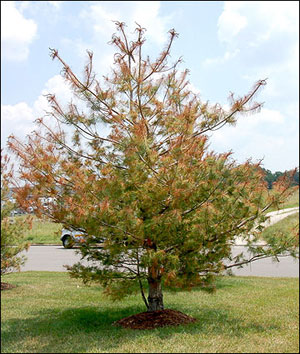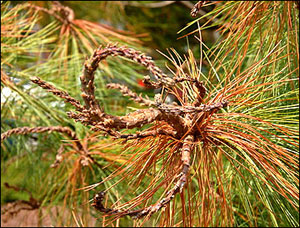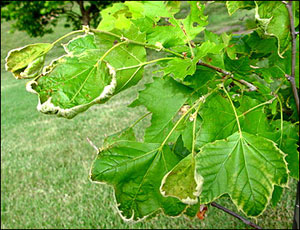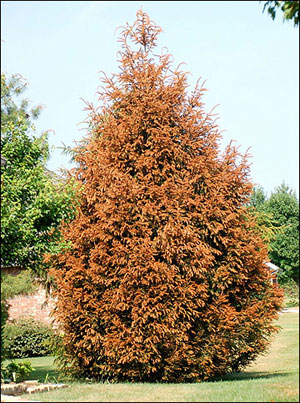Taking an environmentally sensitive approach to pest management
Tree and Shrub Injury Symptoms in Lawns Treated With Imprelis Herbicide
Published: August 1, 2011
Lawn care companies across the country have reported that some trees and shrubs near turf areas treated with a new broadleaf weed killer, Imprelis, showed browning and dieback weeks after the application. Spruce and pine trees have been most severely damaged — some trees dying within 12 weeks of lawn treatment. Damage symptoms also have been observed on many other species of trees and shrubs.

Figure 1 - White pines showing distortion and browning of branch tips.

Figure 2 - White pines showing distortion and browning of branch tips.

Figure 3. Cupping of leaves on a London Planetree.

Figure 4. A severely damaged spruce tree.
Imprelis
Imprelis is a new herbicide, manufactured by DuPont and registered with U.S. Environmental Protection Agency in 2010. The active ingredient in Imprelis is aminocyclopyrachlor, which mimics auxin — a natural-growth regulator in plants. The product is intended for use by professional applicators only. According to the Imprelis product label, the herbicide is quickly taken up by leaves, stems and roots of a weed and is translocated throughout the plant. The product is highly effective in controlling problem weeds such as clover, ground ivy and violets. However, due to the potential for root uptake, the product label states, "particular care must be taken within the dripline of trees and shrubs or other ornamental plants."
Symptoms
New growth on some white pines near Imprelis-treated turf has been observed to be twisted with needles and stems turning brown, especially on upper branches (Figures 1 and 2). In some cases, entire trees have turned brown. Spruce trees also have exhibited browning and dieback of tips with less stem twisting. Symptoms on other species of trees and shrubs are more subtle, with leaves cupping or twisting with little or no browning (Figure 3).
Although it is not clear why trees and shrubs have shown damage symptoms following Imprelis application to lawns, the likely cause is unintended herbicide uptake by the roots of those trees and shrubs. Even in cases where lawn-care operators avoided spraying the herbicide within the drip lines, it appears that tree roots extending into turf areas took up the material, which was then translocated throughout the trees. In most cases, it is physically impossible to spray within the drip line of a spruce tree, since branches extend to the ground (Figure 4).
DuPont recommendations
DuPont recommends allowing trees that show symptoms of possible Imprelis injury to remain in the landscape for one year to see if they recover. Damaged plants should be watered during drought but not fertilized. DuPont recommends that new trees not be planted in areas treated with Imprelis during the same season the product was applied.
Until the situation is clarified, the manufacturer recommends that Imprelis not be sprayed near pine and spruce trees. If dead trees from a treated area are chipped, the chips should not be used as mulch. The Imprelis label also states that grass clippings from treated lawns should not be used for mulch or composting.
Contact information
Homeowners who observe damage symptoms similar to those shown here after herbicide applications should contact their lawn care providers. Professional lawn-care applicators who observe adverse effects, should call DuPont at 888-638-7668 to give information regarding the application site and receive the latest information.
NOTE:
DuPont has made a hotline available as of August 1 to report suspected damage. The hotline number is 866-796-4783. You can find more facts about Imprelis at http://www.imprelis-facts.com/.
Subscribe to receive similar articles sent directly to your inbox!
REVISED: September 29, 2015